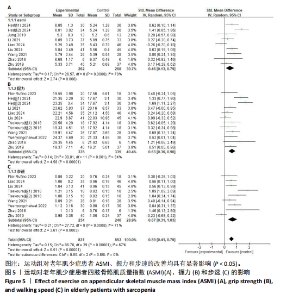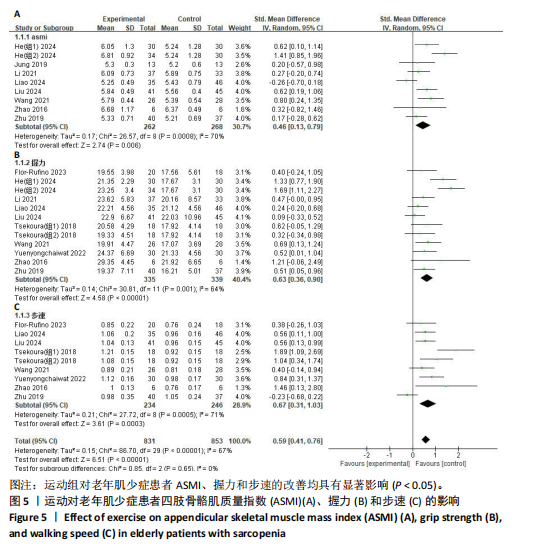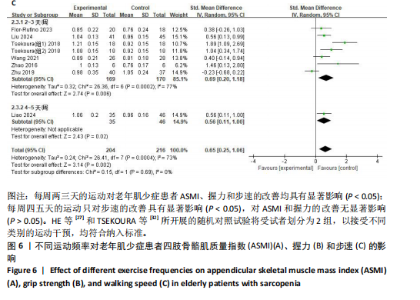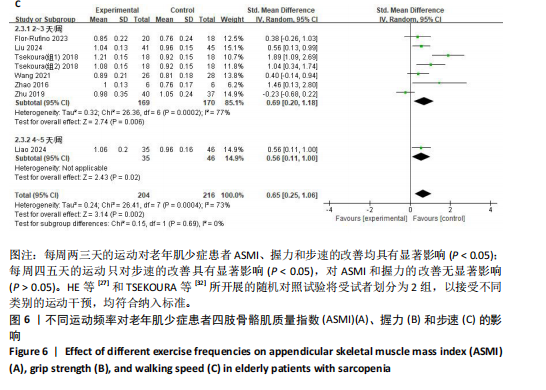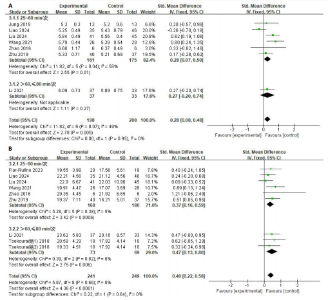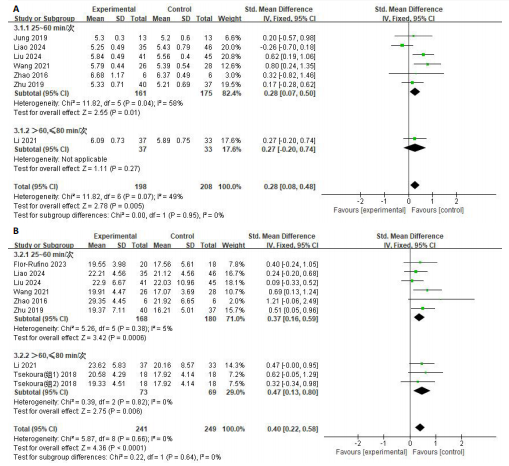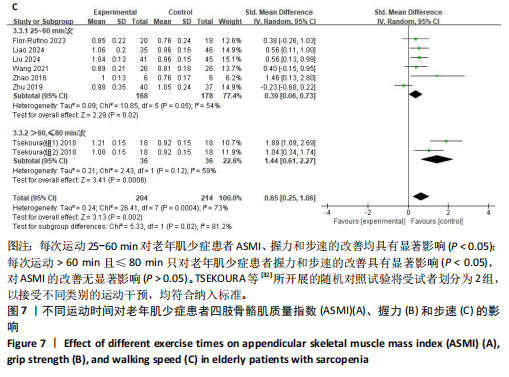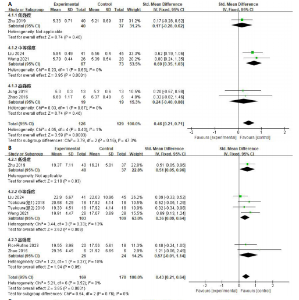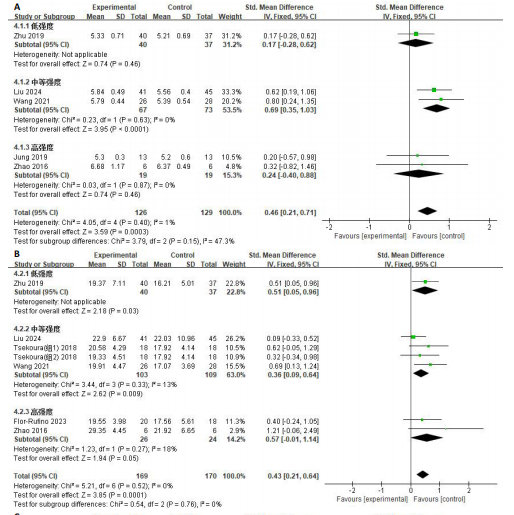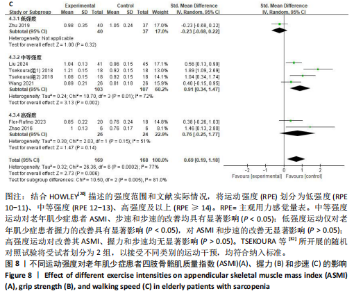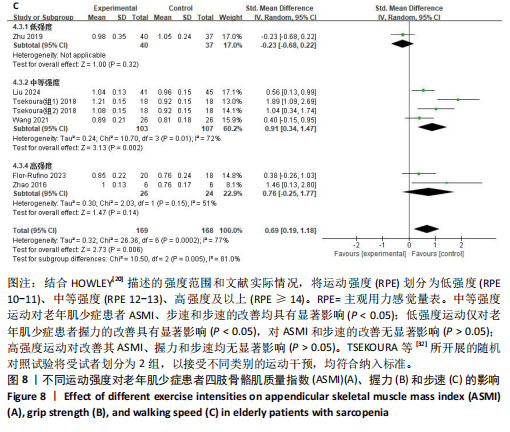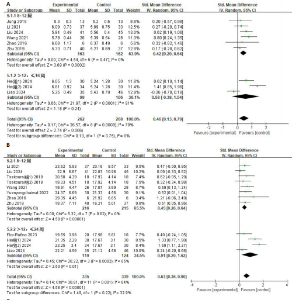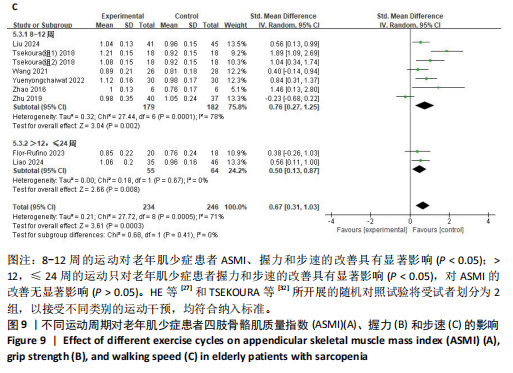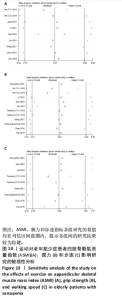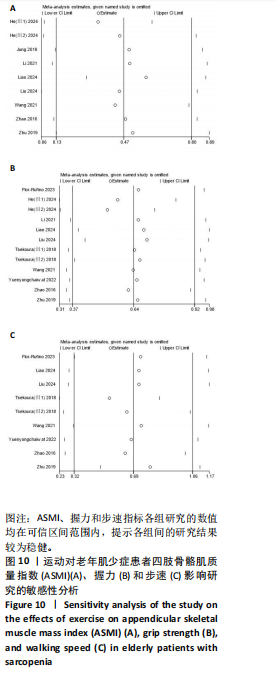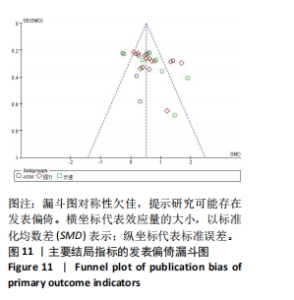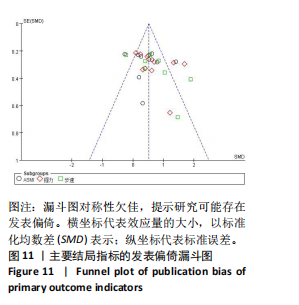Chinese Journal of Tissue Engineering Research ›› 2025, Vol. 29 ›› Issue (29): 6295-6304.doi: 10.12307/2025.791
Previous Articles Next Articles
Meta-analysis of dose-effect of exercise on improving muscle health in community-dwelling older adults with sarcopenia
Jiang Siqi, Huang Huanhuan, Yu Xinyu, Peng Ying, Zhou Wei, Zhao Qinghua
- Nursing Department, First Affiliated Hospital of Chongqing Medical University, Chongqing 400016, China
-
Received:2024-09-02Accepted:2024-10-23Online:2025-10-18Published:2025-03-08 -
Contact:Zhao Qinghua, Professor, Doctoral supervisor, Nursing Department, First Affiliated Hospital of Chongqing Medical University, Chongqing 400016, China -
About author:Jiang Siqi, Master candidate, Nursing Department, First Affiliated Hospital of Chongqing Medical University, Chongqing 400016, China -
Supported by:Key Scientific Research Project of Chongqing Sports Bureau, No. B202301 (to ZQH); Graduate Smart Medicine Special Research and Development Program of Chongqing Medical University, No. YJSZHYX202206 (to HHH)
CLC Number:
Cite this article
Jiang Siqi, Huang Huanhuan, Yu Xinyu, Peng Ying, Zhou Wei, Zhao Qinghua. Meta-analysis of dose-effect of exercise on improving muscle health in community-dwelling older adults with sarcopenia[J]. Chinese Journal of Tissue Engineering Research, 2025, 29(29): 6295-6304.
share this article
Add to citation manager EndNote|Reference Manager|ProCite|BibTeX|RefWorks
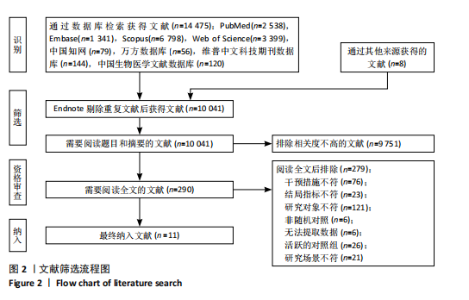
2.1 文献检索结果 初步获得14 483篇文献,去除重复文献后剩余10 041篇,阅读标题和摘要后获得文献290篇。阅读全文后最终纳入11篇文献[24-34],包括中文文献2篇,英文文献9篇。文献筛选流程见图2。 2.2 纳入文献的基本特征及质量评价结果 纳入的11篇文献中,共有研究对象652例,包括试验组患者348例,对照组患者304例。8篇文献同时纳入男性和女性[24,27,29-34],2篇文献仅纳入女性[26,28],1篇文献仅纳入男性[25]。关于肌少症的诊断依据,9篇文献使用亚洲肌少症工作组的标准诊断[24-25,27-31,33-34],2篇文献使用欧洲老年人肌少症工作组的标准[26,32]。运动方式涉及抗阻运动、有氧联合抗阻运动、循环训练以及多组分运动,以抗阻运动居多。其他基本特征见表1。 按照PEDro量表标准,对被纳入研究进行质量评价。整体而言,纳入研究的整体质量为中等,PEDro得分"
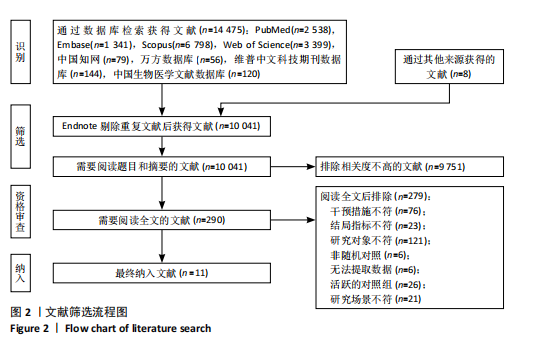
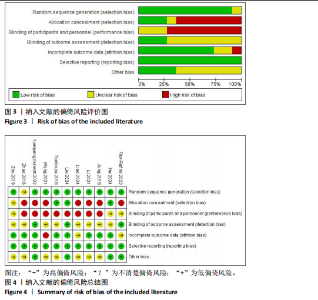
为3-7分,3项研究的得分为6分或以上[31-33],见表1。根据Cochrane偏倚风险评估工具评估得出的偏倚风险结果,如图3,4所示。10篇文献报告了随机序列产生的具体方法[24,26-34],这些方法包括随机数字表法和基于计算机的随机序列法;3篇文献采用了密封信封等方法来实现分配隐藏[27,31-32];1篇文章没有描述样本缺失原因[24];所有文献均未出现选择性报告的情况。此外,由于运动干预的特殊性,施盲难度较大,这可能对纳入文献的方法学质量产生了一定影响。 2.3 Meta分析结果 运动干预可以显著改善老年肌少症患者的ASMI (SMD=0.46,95%CI:0.13-0.79,P= 0.006)、握力(SMD=0.63,95%CI:0.36- 0.90,P < 0.001)和步速(SMD=0.67,95%CI:0.31-1.03,P < 0.001),见图5。 2.3.1 不同运动频率对老年肌少症患者的影响 共计9篇文献被纳入运动频率对老年肌少症患者影响的Meta分析[24-27,29-32,34],8篇文献提供了ASMI变化的数据[24-25,27-31,34],9篇记录了握力改善情况[24-27,29-32,34],7篇研究揭示了步速变化[24-26,30-32,34]。 研究显示,每周两三天的运动对老年肌少症患者ASMI(SMD=0.57,95%CI:0.28-0.86,P < 0.001)、握力(SMD=0.70,95%CI:0.37-1.02,P < 0.001)和步速(SMD=0.69,95%CI:0.20-1.18,P= 0.006)的改善具有中等效应作用;每周四五天的运动仅对老年肌少症患者步速的改善产生中等效应作用(SMD=0.56,95%CI:0.11-1.00,P=0.02),见图6。 2.3.2 不同运动时间对老年肌少症患者的影响 单次运动时间的Meta分析共纳入9篇文献[24-26,28-32,34],其中7篇文献可获得ASMI的结局指标[24-25,28-31,34],8篇文献可获得握力的结局指标[24-26,29-32,34],7篇可获得步速的结局指标[24-26,30-32,34]。 亚组分析结果显示,每次运动25-60 min对提高老年肌少症患者的ASMI (SMD=0.28,95%CI:0.07-0.50,P=0.01)、握力(SMD=0.37,95%CI:0.16- 0.59,P < 0.001)和步速(SMD=0.39,95%CI:0.06-0.73,P=0.02)均产生较小的效应量;每次运动> 60 min且≤"
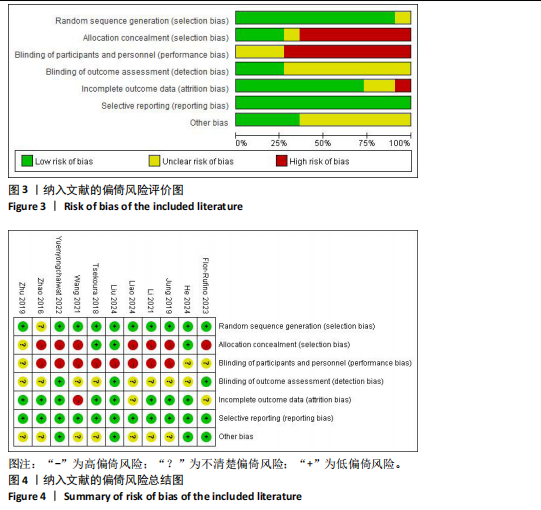
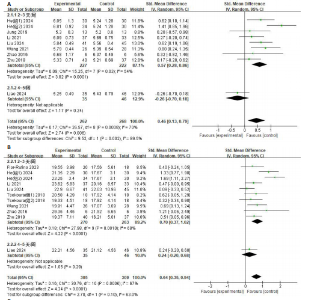
80 min对改善其握力产生较小的效应量(SMD=0.47,95%CI:0.13-0.80,P=0.006),对提高其步速产生较大的效应量(SMD=1.44,95%CI:0.61-2.27,P < 0.001),见图7。 2.3.3 不同运动强度对老年肌少症患者的影响 7篇文献报告了单次运动的强度[24-26,28,31-32,34],其中5篇文献与ASMI有关[24-25,28,31,34],6篇文献与握力有关[24-26,31-32,34],6篇与步速有关[24-26,31-32,34]。不同运动强度的合并效应量显示:低强度运动对改善老年肌少症患者的握力有中等大小效应影响(SMD=0.51,95%CI:0.05-0.96,P=0.03);中等强度对改善其握力(SMD=0.36,95%CI:0.09-0.64,P=0.009)有较小效应影响,对改善其ASMI(SMD=0.69,95%CI:0.35-1.03,P < 0.001)有中等程度效应影响,对改善其步速(SMD=0.91,95%CI:0.34-1.47,P=0.002)产生较大效应影响,见图8。 2.3.4 不同运动周期对老年肌少症患者的影响 纳入11篇文献的运动周期Meta分析显示,其中8篇提供了ASMI改善的数据[24-25,27-31,34],10篇报告了握力改善的数据[24-27,29-34],8篇提供了步速改善的数据[24-26,30-34]。 研究发现,8-12周的运动对老年肌少症患者ASMI(SMD=0.42,95%CI:0.20-0.64,P < 0.001)和握力(SMD= 0.45,95%CI:0.26-0.64,P < 0.001)的改善呈现较小效应量,对步速(SMD=0.76,95%CI:0.27-1.25,P= 0.002)的改善表现为中等效应;> 12周且≤24周的运动对握力的改善有较大效应(SMD=0.91,95%CI:0.20- 1.62,P=0.01),对步速的改善为中等效应(SMD=0.50,95%CI:0.13-0.87,P=0.008),见图9。 2.4 敏感性分析结果 采用剔除法逐一剔除各项研究,敏感性分析结果显示,合并效应量未发生方向性改变,提示Meta分析的结果较稳健,见图10。 2.5 发表偏倚分析 通过绘制漏斗图评估发表偏倚,结果显示各研究左右分布稍有不对称,提示文章存在一定的发表偏倚,这可能与纳入的部分研究质量较低、样本量较小有关,见图11。"
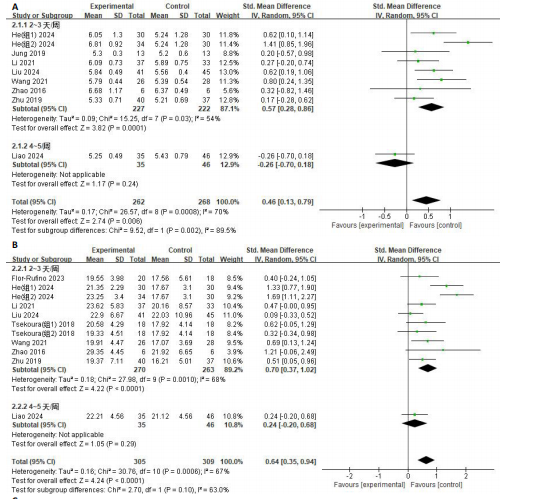
| [1] CRUZ-JENTOFT AJ, SAYER AA. Sarcopenia. Lancet. 2019;393(10191):2636-2646. [2] YE C, ZHENG X, AIHEMAITIJIANG S, et al. Sarcopenia and catastrophic health expenditure by socio‐economic groups in China: an analysis of household‐based panel data. J Cachexia Sarcopenia Muscle. 2022; 13(3):1938-1947. [3] YUAN S, LARSSON SC. Epidemiology of sarcopenia: Prevalence, risk factors, and consequences. Metabolism. 2023;144: 155533. [4] 沈睿, 王茜茜, 徐霓影, 等. 老年肌少症患者运动干预的最佳证据总结[J]. 中华护理杂志,2021,56(10):1560-1566. [5] IZQUIERDO M, MERCHANT RA, MORLEY JE, et al. International Exercise Recommendations in Older Adults (ICFSR): Expert Consensus Guidelines. J Nutr Health Aging. 2021;25(7):824-853. [6] OLIVEIRA JS, PINHEIRO MB, FAIRHALL N, et al. Evidence on Physical Activity and the Prevention of Frailty and Sarcopenia Among Older People: A Systematic Review to Inform the World Health Organization Physical Activity Guidelines. J Phys Act Health. 2020; 17(12):1247-1258. [7] HURST C, ROBINSON SM, WITHAM MD, et al. Resistance exercise as a treatment for sarcopenia: prescription and delivery. Age Ageing. 2022;51(2):afac003. [8] YANG CL, HUANG JP, WANG TT, et al. Effects and parameters of community-based exercise on motor symptoms in Parkinson’s disease: a meta-analysis. BMC Neurol. 2022; 22(1):505. [9] PAGE MJ, MCKENZIE JE, BOSSUYT PM, et al. The PRISMA 2020 statement: an updated guideline for reporting systematic reviews. BMJ. 2021;372:n71. [10] CHEN LK. Sarcopenia in Asia: Consensus Report of the Asian Working Group for Sarcopenia. J Am Med Dir Assoc. 2014; 15(2):95-101. [11] CHEN LK, LEE WJ, PENG LN, et al. Recent Advances in Sarcopenia Research in Asia: 2016 Update From the Asian Working Group for Sarcopenia. J Am Med Dir Assoc. 2016;17(8):767.e1-7. [12] CHEN LK, WOO J, ASSANTACHAI P, et al. Asian Working Group for Sarcopenia: 2019 Consensus Update on Sarcopenia Diagnosis and Treatment. J Am Med Dir Assoc. 2020; 21(3):300-307.e2. [13] CRUZ-JENTOFT AJ, BAEYENS JP, BAUER JM, et al. Sarcopenia: European consensus on definition and diagnosis. Age Ageing. 2010; 39(4):412-423. [14] CRUZ-JENTOFT AJ, BAHAT G, BAUER J, et al. Sarcopenia: revised European consensus on definition and diagnosis. Age Ageing. 2019; 48(1):16-31. [15] DRAHOTA A, UDELL JE, MACKENZIE H, et al. Psychological and educational interventions for preventing falls in older people living in the community. Cochrane Database Syst Rev. 2024;10(10):CD013480. [16] GALLARDO-GÓMEZ D, SALAZAR-MARTÍNEZ E, ALFONSO-ROSA RM, et al. Optimal Dose and Type of Physical Activity to Improve Glycemic Control in People Diagnosed With Type 2 Diabetes: A Systematic Review and Meta-analysis. Diabetes Care. 2024;47(2): 295-303. [17] 刘海宁, 吴昊, 姚灿, 等. Meta分析中连续性数据的深度提取方法[J]. 中国循证医学杂志,2017,17(1):117-121. [18] JAYEDI A, EMADI A, SHAB-BIDAR S. Dose-Dependent Effect of Supervised Aerobic Exercise on HbA1c in Patients with Type 2 Diabetes: A Meta-analysis of Randomized Controlled Trials. Sports Med. 2022;52(8): 1919-1938. [19] ASHOR AW, LARA J, SIERVO M, et al. Exercise Modalities and Endothelial Function: A Systematic Review and Dose–Response Meta-Analysis of Randomized Controlled Trials. Sports Med. 2015;45(2):279-296. [20] HOWLEY ET. Type of activity: resistance, aerobic and leisure versus occupational physical activity. Med Sci Sports Exerc. 2001; 33(6 Suppl):S364-369;discussion S419-420. [21] HIGGINS JPT, ALTMAN DG, GØTZSCHE PC, et al. The Cochrane Collaboration’s tool for assessing risk of bias in randomised trials. BMJ. 2011;343:d5928. [22] MOSELEY AM, RAHMAN P, WELLS GA, et al. Agreement between the Cochrane risk of bias tool and Physiotherapy Evidence Database (PEDro) scale: A meta-epidemiological study of randomized controlled trials of physical therapy interventions. PloS One. 2019;14(9): e0222770. [23] DE ALMEIDA FO, SANTANA V, CORCOS DM, et al. Effects of Endurance Training on Motor Signs of Parkinson’s Disease: A Systematic Review and Meta-Analysis. Sports Med. 2022;52(8):1789-1815. [24] 王光辉, 蔡文玮, 沈晓君, 等. 弹力带抗阻运动训练12周对社区老年肌少症患者肌力的影响[J]. 中国临床保健杂志,2021, 24(6):800-804. [25] 赵永军, 张育民, 郭艳花, 等. 推拿结合抗阻运动对骨骼肌衰减症患者日常生活活动能力的影响[J]. 中国康复医学杂志, 2016,31(9):989-994. [26] FLOR-RUFINO C, BARRACHINA-IGUAL J, PÉREZ-ROS P, et al. Fat infiltration and muscle hydration improve after high-intensity resistance training in women with sarcopenia. A randomized clinical trial. Maturitas. 2023;168:29-36. [27] HE S, WEI M, MENG D, et al. Self-determined sequence exercise program for elderly with sarcopenia: A Randomized controlled trial with clinical assistance from explainable artificial intelligence. Arch Gerontol Geriatr. 2024;119:105317. [28] JUNG WS, KIM YY, PARK HY. Circuit Training Improvements in Korean Women with Sarcopenia. Percept Mot Skills. 2019; 126(5):828-842. [29] LI Z, CUI M, YU K, et al. Effects of nutrition supplementation and physical exercise on muscle mass, muscle strength and fat mass among sarcopenic elderly: a randomized controlled trial. Appl Physiol Nutr Metab. 2021;46(5):494-500. [30] LIAO X, CHENG D, LI J, et al. Effects of oral oligopeptide preparation and exercise intervention in older people with sarcopenia: a randomized controlled trial. BMC Geriatr. 2024;24(1):260. [31] LIU M, LI J, XU J, et al. Graded Progressive Home-Based Resistance Combined with Aerobic Exercise in Community-Dwelling Older Adults with Sarcopenia: A Randomized Controlled Trial. Clin Interv Aging. 2024;19: 1581-1595. [32] TSEKOURA M, BILLIS E, TSEPIS E, et al. The Effects of Group and Home-Based Exercise Programs in Elderly with Sarcopenia: A Randomized Controlled Trial. J Clin Med. 2018;7(12):480. [33] YUENYONGCHAIWAT K, AKEKAWATCHAI C. Beneficial effects of walking-based home program for improving cardio-respiratory performance and physical activity in sarcopenic older people: a randomized controlled trial. Eur J Phys Rehabil Med. 2022;58(6):838-844. [34] ZHU LY, CHAN R, KWOK T, et al. Effects of exercise and nutrition supplementation in community-dwelling older Chinese people with sarcopenia: a randomized controlled trial. Age Ageing. 2019;48(2):220-228. [35] ZHANG Y, ZOU L, CHEN ST, et al. Effects and Moderators of Exercise on Sarcopenic Components in Sarcopenic Elderly: A Systematic Review and Meta-Analysis. Front Med. 2021;8:649748. [36] BAO W, SUN Y, ZHANG T, et al. Exercise Programs for Muscle Mass, Muscle Strength and Physical Performance in Older Adults with Sarcopenia: A Systematic Review and Meta-Analysis. Aging Dis. 2020;11(4):863-873. [37] HASSAN BH, HEWITT J, KEOGH JWL, et al. Impact of resistance training on sarcopenia in nursing care facilities: A pilot study. Geriatr Nurs. 2016;37(2):116-121. [38] DOS SANTOS VR, ANTUNES M, DOS SANTOS L, et al. Effects of Different Resistance Training Frequencies on Body Composition, Muscular Strength, Muscle Quality, and Metabolic Biomarkers in Sarcopenic Older Women. J Strength Cond Res. 2024;38(9): e521. [39] LIU M, MEI DH, ZHANG YL, et al. Meta-analysis of exercise intervention on health behaviors in middle-aged and older adults. Front Psychol. 2024;14:1308602. [40] APPELL HJ, SOARES JMC, DUARTE JAR. Exercise, Muscle Damage and Fatigue. Sports Med. 1992;13(2):108-115. [41] 赵婉越, 张伯煜, 孙婷, 等. 运动改善老年人衰弱状况的剂量效应Meta分析[J]. 中国慢性病预防与控制,2023,31(11): 860-866. [42] TAN TW, TAN HL, HSU MF, et al. Effect of non-pharmacological interventions on the prevention of sarcopenia in menopausal women: a systematic review and meta-analysis of randomized controlled trials. BMC Women’s Health. 2023;23(1):606. [43] 郝莹, 陈卓. 抗阻运动提升老年人下肢肌肉力量及功能状态的网状Meta分析[J]. 中国循证医学杂志,2024,24(2):175-182. [44] HUANG LY, LIM AY, HSU CC, et al. Sustainability of exercise-induced benefits on circulating MicroRNAs and physical fitness in community-dwelling older adults: a randomized controlled trial with follow up. BMC Geriatr. 2024;24(1):473. [45] NAMBI G, ABDELBASSET WK, ALRAWAILI SM, et al. Comparative effectiveness study of low versus high-intensity aerobic training with resistance training in community-dwelling older men with post-COVID 19 sarcopenia: A randomized controlled trial. Clin Rehabil. 2022;36(1):59-68. [46] TAN KHL, SIAH CJR. Effects of low-to-moderate physical activities on older adults with chronic diseases: A systematic review and meta-analysis. J Clin Nurs. 2022;31(15-16):2072-2086. [47] CHEN N, HE X, FENG Y, et al. Effects of resistance training in healthy older people with sarcopenia: a systematic review and meta-analysis of randomized controlled trials. Eur Rev Aging Phys Act. 2021;18(1): 23. [48] ZHUANG M, JIN M, LU T, et al. Effects of three modes of physical activity on physical fitness and hematological parameters in older people with sarcopenic obesity: A systematic review and meta-analysis. Front Physiol. 2022;13:917525. [49] CHANG MC, LEE AY, KWAK S, et al. Effect of Resistance Exercise on Depression in Mild Alzheimer Disease Patients With Sarcopenia. Am J Geriatr Psychiatry. 2020;28(5):587-589. [50] SEN EI, EYIGOR S, YAGLI MD, et al. Effect of Home-Based Exercise Program on Physical Function and Balance in Older Adults With Sarcopenia: A Multicenter Randomized Controlled Study. J Aging Phys Activ. 2021; 29(6):1010-1017. [51] 王丽丽, 田丽雅, 牛琪, 等. 11种运动对老年肌少症患者身体功能改善效果的网状Meta分析[J]. 中华护理杂志,2022, 57(21):2652-2660. |
| [1] | Zhang Xinxin, Gao Ke, Xie Shidong, Tuo Haowen, Jing Feiyue, Liu Weiguo. Network meta-analysis of non-surgical treatments for foot and ankle ability and dynamic balance in patients with chronic ankle instability [J]. Chinese Journal of Tissue Engineering Research, 2025, 29(9): 1931-1944. |
| [2] | Sun Yundi, Cheng Lulu, Wan Haili, Chang Ying, Xiong Wenjuan, Xia Yuan. Effect of neuromuscular exercise for knee osteoarthritis pain and function: a meta-analysis [J]. Chinese Journal of Tissue Engineering Research, 2025, 29(9): 1945-1952. |
| [3] | Wang Qiuyue, Jin Pan, Pu Rui . Exercise intervention and the role of pyroptosis in osteoarthritis [J]. Chinese Journal of Tissue Engineering Research, 2025, 29(8): 1667-1675. |
| [4] | Wang Yida, Liu Jun, Wang Xiaoling, Wang Liyan, Yang Chengru, Zhang Xuexiao. Effects of wearable electronic device-based interventions on physical activity and sedentary behavior in healthy adolescents: a meta-analysis [J]. Chinese Journal of Tissue Engineering Research, 2025, 29(8): 1693-1704. |
| [5] | Zhang Zixian, Xu Youliang, Wu Shaokui, Wang Xiangying. Effects of blood flow restriction training combined with resistance training on muscle indicators in college athletes: a meta-analysis [J]. Chinese Journal of Tissue Engineering Research, 2025, 29(8): 1705-1713. |
| [6] | Wang Juan, Wang Guanglan, Zuo Huiwu. Efficacy of exercise therapy in the treatment of anterior cruciate ligament reconstruction patients: #br# a network meta-analysis #br# [J]. Chinese Journal of Tissue Engineering Research, 2025, 29(8): 1714-1726. |
| [7] | Zheng Huakun, Yin Mingyue, Liu Qian. Effects of interval and continuous training on the quality of life in physically inactive adults: a meta-analysis [J]. Chinese Journal of Tissue Engineering Research, 2025, 29(8): 1727-1740. |
| [8] | Lou Guo, Zhang Min, Fu Changxi. Exercise preconditioning for eight weeks enhances therapeutic effect of adipose-derived stem cells in rats with myocardial infarction [J]. Chinese Journal of Tissue Engineering Research, 2025, 29(7): 1363-1370. |
| [9] | Zheng Rongfa, Mo Weibin, Huang Peng, Chen Junji, Liang Ting, Zi Fangyu, Li Guofeng. Effects of electroacupuncture on the expression of metabolic enzymes and autophagy genes in gastrocnemius muscle tissues of exercising rats [J]. Chinese Journal of Tissue Engineering Research, 2025, 29(6): 1127-1136. |
| [10] | Zhao Xiaoxuan, Liu Shuaiyi, Li Qi, Xing Zheng, Li Qingwen, Chu Xiaolei. Different exercise modalities promote functional recovery after peripheral nerve injury [J]. Chinese Journal of Tissue Engineering Research, 2025, 29(6): 1248-1256. |
| [11] | Zhang Wenhua, Li Xun, Zhang Weichao, Li Xinying, Ma Guoao, Wang Xiaoqiang . Promoting myogenesis based on the SphK1/S1P/S1PR2 signaling pathway: a new perspective on improving skeletal muscle health through exercise [J]. Chinese Journal of Tissue Engineering Research, 2025, 29(6): 1265-1275. |
| [12] | Ma Haoyu, Qiao Hongchao, Hao Qianqian, Shi Dongbo. Causal effects of different exercise intensities on the risk of osteoarthritis [J]. Chinese Journal of Tissue Engineering Research, 2025, 29(6): 1305-1311. |
| [13] | Wang Dongyang, Yang Qiaohui, Lin Xinchao. Relationship between vitamin D levels and reproductive characteristics and exercise dietary situation in postmenopausal women [J]. Chinese Journal of Tissue Engineering Research, 2025, 29(5): 1021-1025. |
| [14] | Li Zhe, Li Ping, Zhang Chao, Guo Guangling. A network meta-analysis of efficacy of mesenchymal stem cells from different sources in treatment of premature ovarian failure animal models [J]. Chinese Journal of Tissue Engineering Research, 2025, 29(36): 7898-7908. |
| [15] | Wang Kaigang, Hao Dongsheng, Ma Pei, Zhou Shuo, Li Ruimin. Comparison of efficacy of different biological scaffolds for pulp regeneration therapy in immature permanent teeth: a Bayesian network meta-analysis [J]. Chinese Journal of Tissue Engineering Research, 2025, 29(34): 7447-7460. |
| Viewed | ||||||
|
Full text |
|
|||||
|
Abstract |
|
|||||
